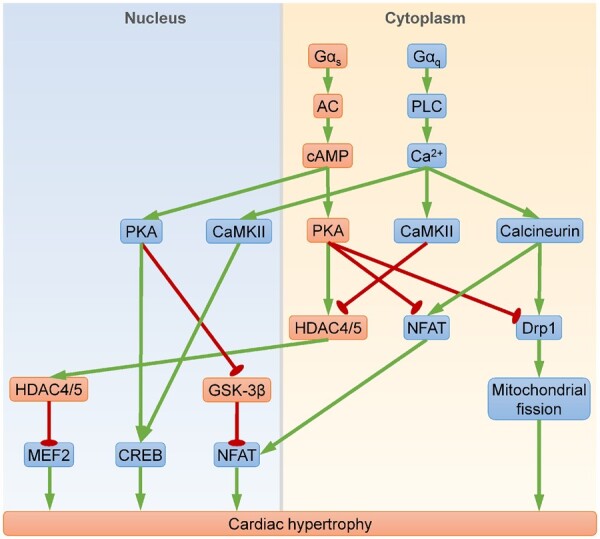Figure 3.

PKA signalling in cardiac hypertrophy. Key molecular events contributing to cardiac hypertrophy include MEF2-, CREB-, NFAT-mediated gene transcription, or Drp1-mediated mitochondrial fission. Gαs stimulates synthesis of the second messenger cAMP, which activates nuclear PKA to induce hypertrophy and cytoplasmic PKA to inhibit hypertrophy. Nuclear PKA promotes hypertrophy through: (i) activating CREB; and (ii) alleviating GSK-3β-mediated NFAT repression. Cytoplasmic PKA inhibits hypertrophy through: (i) invoking HDAC4/5-mediated MEF2 repression; (ii) inactivating NFAT; and (iii) suppressing Drp1. By contrast, Gαq acts through the second messenger Ca2+ to provoke Ca2+/CaMKII- and calcineurin-mediated hypertrophy. CaMKII activates MEF2 and CREB, whereas calcineurin activates NFAT and Drp1. Nuclear PKA may act cooperatively with CaMKII and calcineurin to induce hypertrophy, but cytoplasmic PKA antagonizes CaMKII- and calcineurin-dependent hypertrophy. AC, adenylyl cyclase; CaMKII, Ca2+/calmodulin-dependent protein kinase type II; CREB, cAMP-response element binding protein; GSK-3β, glycogen synthase kinase-3β; HDAC4/5, histone deacetylase 4/5; MEF2, myocyte enhancer factor 2; NFAT, nuclear factor of activated T cells; PLC, phospholipase C. Arrows indicate activation; bar-headed lines indicate inhibition.
